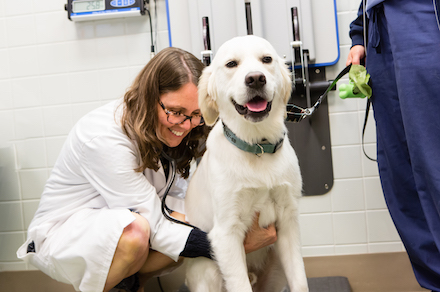Fever in Dogs in Cats

Background
A fever is an abnormally high body temperature. A normal body temperature for a cat or dog is between 100 and 102.5°F (37.8 to 39.2°). A cat or dog is considered to have a true fever if their body temperature ranges from 103 to 106°F (39.5 to 41.1°C).
When to see a veterinarian:
If your pet has a temperature between 102.5 to 104.5°F (39.2 to 40.3°C), consult your veterinarian. For temperatures above 104.5°F (40.3°C), seek immediate veterinary attention.
Signs
Since the body temperature of a cat or a dog is higher than a human’s, a touch to the forehead or skin may not tell you if your pet is feverish. The only way to determine if your pet has a fever is by taking their temperature.
You can take your cat or dog’s body temperature at home by using a standard rectal thermometer. The thermometer should be lubricated with petroleum jelly and gently inserted into the rectum until only one inch is visible. The thermometer should be left inserted for one minute before reading the temperature.
In addition to the high body temperature, a fever may also be accompanied by shivering as the body attempts to produce heat through muscle contractions.
Possible Causes
There are many reasons your pet may develop a fever, including an infection, autoimmune disease, allergic reaction, toxin ingestion, reaction to certain drugs, vaccination, or cancer. Here are some potential causes:
- Cancer or Tumor A continuous fever with no obvious cause can be due to an undetected cancer, such as leukemia or lymphoma. Cancer is a disease in which abnormal cells grow and reproduce, often in a mass called a tumor. These abnormal cells have the ability to spread to surrounding tissues or other areas in the body.
- Coccidioidomycosis (Valley Fever) Coccidioidomycosis (also known as Valley Fever) is a type of fungal infection caused by the inhalation of the fungus Coccidioides immitis in dogs. Valley fever is primarily a respiratory disease but the infection can spread throughout the body, such as the eyes, joints, and bone, resulting in a chronic cough, loss of appetite, lameness, enlarged joints, fever, and diarrhea.
- Canine Distemper Canine distemper is a contagious viral disease that has a wide range of clinical signs, including a fever, runny nose, red eyes, vomiting, diarrhea, and inflammation of the lungs and brain. The virus can infect a variety of species, including dogs, foxes, racoons, and skunks.
- Meningitis Meningitis refers to the inflammation of membrane which covers the brain and spinal cord. It can also be seen simultaneously with inflammation of the brain itself (encephalitis). Meningitis results from an infection, typically by a virus, protozoa, or fungus. Common signs of meningitis are fever, neck pain, rigidity in the neck, and muscle spasms.
- Feline Infectious Peritonitis (FIP) Feline infectious peritonitis (FIP) is an infectious and often fatal disease in cats caused by a coronavirus, although only a few cats will develop the severe form of the disease. Various organs may be affected by the disease, including the liver, kidneys, pancreas, central nervous system, and eyes. Depending on the organs affected, a cat may display signs such as fluid buildup in the abdomen, difficulty breathing, a chronic fever, loss of appetite, weight loss, and depression.
- Feline Leukemia Virus (FeLV) Feline leukemia virus (FeLV) is a viral infection that attacks a cat’s immune system, weakening its ability to fight off other infections.
- Feline Panleukopenia Feline panleukopenia is a highly contagious and often fatal disease in cats that results in an abnormally low white blood cell count.
- Infection or Abscess An infection or abscess on a part of the body, such as the ears, mouth, or skin, can result in a fever.
- Leptospirosis Leptospirosis is an infectious disease caused by the bacteria Leptospira, which is shed through urine. Direct contact with infected urine or other contaminated sources, such as soil or water, can result in infection.
- Lyme Disease Lyme disease is caused by the transmission of the bacteria Borrelia burgdorferi through a tick bite. The most common signs of Lyme disease in dogs include fever, loss of appetite, swollen joints, lameness, swollen lymph nodes, and lethargy.
- Mastitis Mastitis refers to the inflammation of the mammary glands, which produce milk. This condition is often caused by a bacterial infection after an animal has given birth.
- Pancreatitis Pancreatitis refers to the inflammation of the pancreas.
- Canine Parvovirus Canine parvovirus is a highly contagious and potentially fatal viral disease that affects the gastrointestinal tract and bone marrow, leading to severe diarrhea and a low white blood cell count.
- Pneumonia Pneumonia refers to inflammation of the lungs, which can be caused by a bacterial or viral infection.
- Pyelonephritis Pyelonephritis is a bacterial infection of the kidneys.
- Pyometra Pyometra is a bacterial infection of the uterus due to hormonal changes in unspayed cats and dogs.
- Rocky Mountain Spotted Fever (Tick Fever) Rocky Mountain spotted fever is caused by the bacteria Rickettsia rickettsia transmitted through the bites of infected ticks. Early signs of infection in dogs are a fever, loss of appetite, enlarged lymph nodes, inflammation of joints, coughing, difficulty breathing, abdominal pain, vomiting, diarrhea, and swelling.
- Toxin Ingestion
- Urinary Tract Infection (UTI) A urinary tract infection (UTI) can result in a fever.
Diagnosis
The only way to determine if a pet has a fever is by taking their temperature. A cat or dog is considered to have a true fever if their body temperature ranges from 103 to 106°F (39.5 to 41.1°C).
As fevers are usually the result of an underlying infection, your veterinarian can diagnose your pet by assessing its medical history, performing a thorough physical exam, and ordering tests such as an x-ray, urinalysis, or blood test.
A fever is referred to as a fever of unknown origin if the underlying cause cannot be determined. Specialized testing may be required, such as additional blood tests, tests for specific infectious diseases, joint fluid tests, ultrasounds, biopsies, body fluid cultures, x-rays, CT scans, MRI scans, or exploratory surgery.
Treatment
Successfully managing a fever requires treatment of the underlying condition or disease. As fevers are usually the result of an underlying infection, fevers caused by bacterial infections can typically be treated with antibiotics, whereas fevers caused by viral infections can be treated with antiviral drugs.
Prevention
There are steps pet owners can take to protect their pets against infectious diseases that cause fevers. Pet owners should make sure their cat or dog is up to date on their required vaccinations. If an infection is already present, a veterinarian may prescribe antibiotics or other medications to prevent the infection from developing further.
Make an Appointment





























